
We take a journey to the epicenter of the earthquake in Haiti. We go from Port-au-Prince, through Carrefour and Gressier to Léogâne. Earthquake survivors talk about the lack of any outside help as they continue to dig out their dead from the rubble and bury them in mass graves. [includes rush transcript]
Transcript
AMY GOODMAN: As Ti Rosemond headed off to Cap-Haïtien with many others, we began our trip.
This is Democracy Now!, democracynow.org, The War and Peace Report. I’m Amy Goodman.
I traveled with Democracy Now!’s Sharif Abdel Kouddous and Elizabeth Press and Kim Ives of Haiti Liberté. This is “Tè Tremblé, The Earth Trembles: Journey to the Epicenter of the Quake.”
AMY GOODMAN: We’re on the road from Port-au-Prince to Léogâne. This area is considered the epicenter. Port-au-Prince, the destruction is unimaginable, as we pass the palace, we pass the Ministry of Justice. They’re destroyed. Thousands of people in camps are just camping out outside in downtown Port-au-Prince. And then, everywhere else are smaller camps. By “smaller camps,” it could be everything from thirty people to, oh, a thousand people on soccer fields. Then we went through Carrefour. Gressier is where we are right now, the epicenter — and then Léogâne — of the earthquake.
Well, we just stopped and spoke to a young man, who said, “No media here. No medical help.” They see the helicopters, but they don’t land, and the mass graves. This is Stevenson Calixte.
STEVENSON CALIXTE: [translated] Up until now, people are suffering. [inaudible] People are wounded. They have broken bones. And they haven’t done anything. There are no doctors. There’s nothing, nothing here. We, here in Gressier, we don’t have anything. And they haven’t told us anything, either. And for the wounded, we can’t even figure out. And 98 percent of the houses have been destroyed.
AMY GOODMAN: Where are the people buried?
STEVENSON CALIXTE: [translated] They made a hole up here. Some places, they made mass graves.
AMY GOODMAN: Are people still caught in the rubble?
STEVENSON CALIXTE: [translated] Yes, yes, up until now. We don’t know if they’re living or dead. There’s nothing. We have no means to know if they’re living or dead. The only thing I know, everywhere you go, when you smell the odor, you know that there are people dead there.
AMY GOODMAN: And now we have just come to Léogâne, where the United Nations says they will not be sending aid until they can, quote, “secure the area.” We are not sure what we’re going to find here. But at the same time, the UN says this is the worst —- this is the worst hit of this earthquake. With 90 percent of the houses, the buildings down, they expect that thousands of people, perhaps 10,000 people, are entombed in buildings. As we came upon this road, we see that the destruction is almost total. We’re going to walk down it.
What happened the day of the earthquake?
LÉOGÂNE WOMAN 1: [translated] On Tuesday the 12th, there was an earthquake. The walls all fell down.
LÉOGÂNE MAN 1: [translated] We heard a noise. It was like a tractor coming -— da da da da. And we saw all the houses shaking back and forth. The only chance you had, and God help you, had the privilege to run, and you saw that all the houses coming down. And a wall fell on her head.
LÉOGÂNE WOMAN 1: [translated] And it fell on me and on my back.
KIM IVES: We can look at her back.
AMY GOODMAN: And has there been any medical aid?
LÉOGÂNE MAN 1: [translated] No, up until now, no. We went to the MINUSTAH, but her state was so bad.
AMY GOODMAN: The United Nations?
LÉOGÂNE WOMAN 1: [translated] The United Nations. But they didn’t have anesthesia, because her head was cut open, but they didn’t have any anesthesia to do anything.
AMY GOODMAN: Tell us what it is you need, one by one.
LÉOGÂNE MAN 2: [translated] Myself, if you look at me, I don’t have shoes, and I don’t have food. Even my shoes, if you look at them, you see. I need clothes. We need everything. Even medicines, we need.
LÉOGÂNE WOMAN 2: [translated] And a lot of food and water to drink. We don’t have water or food.
LÉOGÂNE WOMAN 3: [translated] And also, we’re cold. We’re cold. If the rain comes, we’re all going to die, because the cold is bad for us. Our noses are blocked. The mosquitoes are eating us. And all the bugs in the ground get on us. We need for them to come with a tent. Even if they don’t have time to make houses, a tent — then we could get under the tent, at least.
AMY GOODMAN: Those were the voices of Jerusalem Road, right on the outskirts of Léogâne. We’ve moved in now. People are extremely frustrated. They said they’ve seen no medical, no authorities, no — no one has come to help them.
We’re standing right now in front of a house where a child was pulled out by his father this morning who was one year old. He was buried in the rubble for days. We will now go to talk to people about what has happened here and see his and others’ graves.
LÉOGÂNE MAN 3: [translated] The problem that happened here, during the earthquake, there were people on the first floor. There were some children there. And it fell on him. We put chains to try to lift those things. But in this corner over here, they were trying to take lessons, and the wall fell on them. They were taking lessons behind, and they were running to come out into the road, and the wall fell down on them. And they took out those two children who died, and they buried them.
AMY GOODMAN: Who is “they”? Who took them out?
LÉOGÂNE MAN 3: [translated] We, who live in the area, did it. We broke down the cement, because the odor was too much for us to take.
AMY GOODMAN: And where are they buried?
LÉOGÂNE MAN 3: [translated] And they are buried right here, behind us.
AMY GOODMAN: Can you show us?
LÉOGÂNE MAN 3: [translated] This is one of them under this pile of leaves here and over on this — and this over to our left is the other pile. They put two together over here. They buried two together. And this is a child here, buried here where they’re pointing. And another one buried over there.
AMY GOODMAN: How old were the children? And can you tell us what their names were?
FRANKENSON CHARITEL: [translated] This one over here was called Brendial [phon., and he had four years old. This was Lins Sacage [phon.]. He was one year old.
AMY GOODMAN: How do you know them?
FRANKENSON CHARITEL: [translated] That was my little nephew there. When the earthquake happened, I went out — ran out with him. We were inside together. I ran and left him in there. We had to break the cement to go get him. Yesterday we took him out. His father took him out. His father took him out.
AMY GOODMAN: What is your name, and how old are you?
FRANKENSON CHARITEL: [translated] I’m seventeen years old, and my name is Frankenson Charitel [phon.].
AMY GOODMAN: Where were you when the earthquake hit?
FRANKENSON CHARITEL: [translated] I was in that house there studying, in my house studying. As the ground began to tremble — they used to throw rocks at the house. I thought it was people throwing rocks. Then I heard the noise, and I ran out. And then, when I ran out, people came and got me. When I was turning back to go get the child, the house fell down on him.
AMY GOODMAN: The baby Lins was buried here in the rubble. His crib or his bassinet that we see, that his father just pulled him out of this morning, six days after the earthquake.
LÉOGÂNE MAN 4: [translated] People were not prepared for this earthquake. The food that they had at home didn’t suffice. And now it’s been a week. They can’t continue anymore. There are people with broken bones. They need medical aid. We haven’t found any authorities who have come to give them aid. There are some there who are with broken legs. There are kids with broken arms, which haven’t found care. And there are a lot of people underneath the debris, and they haven’t taken them out. And this week now we see that there’s a bad smell starting to come out, which can infect us in here in this neighborhood. We would ask the international community to come as soon as possible to take away those bodies for us, so we can breathe better. As for water, if the rain comes, that will be a poison for us. We need their presence as soon as possible, because we see they were stabilizing in the capital. After Port-au-Prince, it’s Léogâne which is the most damaged.
AMY GOODMAN: Have you seen any doctors come? Any UN, any US representatives? Has any food, any aid come to Léogâne?
LÉOGÂNE MAN 4: [translated] No, we haven’t seen it. This is the first delegation which has done an interview with us since last Tuesday. We don’t have doctors. And we have children living in this neighborhood, and we don’t think that the odor that you smell here is good for them.
AMY GOODMAN: How many people do you estimate have died here?
LÉOGÂNE MAN 4: [translated] A lot of people have died. We can’t make an estimate.
AMY GOODMAN: I’m standing in front of the house of Carline Cicero. They just dug her out today. She was twenty-five years old. And they buried her near the water among the banana trees. And right near us is Roland Pierre, and Roland is using a mallet to try to unearth his grandfather, who is buried in the rubble. His grandfather’s name is Génius Jean-Louis. The smell here is very bad. Many people try to wear bandannas or hospital masks if they happen to have them.
ROLAND PIERRE: [translated] I’m digging here to see if I can take out some of the dead people in this hole behind me. This is my grandfather who’s here behind me.
KIM IVES: How many other dead do you think are here?
ROLAND PIERRE: [translated] There’s only one more dead here. It was four who died here, but now there’s just one left to dig out.
STANLEY RAYMOND: [translated] My name is Stanley Raymond. I’m the president of this church committee, which is the Flame of Christ. This is a praise we’re giving to God. This allows us, because we, even though the church is destroyed and our houses are destroyed, but we, we didn’t die.
AMY GOODMAN: What is your message to the world?
STANLEY RAYMOND: [translated] The message I have for the world: They should bring us aid also, because no nation is spared. This could happen to anybody. I hope they don’t take it lightly because we’re black and because we’re a poor country. Despite everything, they take consciousness, and they think that what happened to us could happen to them.
AMY GOODMAN:
As we travel through the center of Léogâne, we’re right across from a refugee camp of who knows how many hundreds of people, perhaps thousands traveling through, those who’ve lost their homes and those who are afraid to go back because their homes might also crumble, perhaps in the aftershocks, or just shift. I’m standing in front of the church where Jean-Jacques Dessalines was married. Jean-Jacques Dessalines was the founding father of Haiti, January 1st, 1804, the victory was won against the French, against Napoleon, and Jean-Jacques Dessalines and his men declared the independent Republic of Haiti.
FATHER MARAT GUIREND: My name is Father Marat Guirend. When I was in my rectory inside, we have many problems with — I don’t know how to say that, the tremblement de terre. I had about 400 children with me. I had some food. I had some food to give them. In the same time, I hear a noise, a bad noise in my ears. In the same time the children go [inaudible]. And now, at the same time, you see the situation of my church.
AMY GOODMAN:
What do you need?
FATHER MARAT GUIREND: If you can get some help for us, because I want to build the church, my rectory also. I don’t know if you have the possibility to get something for us, because I don’t know what to do. I don’t know what to do.
AMY GOODMAN:
As I was walking to Saint Rose de Lima Church, Dessalines’ church, the founding father, the founding fighter of Haiti, I bumped into an American resident who lives here in Léogâne. What is your name?
JEAN ROMERO DAMOUR:
Jean Romero Damour. Jean Romero Damour.
AMY GOODMAN:
And you own this house, but also you just built the house behind it?
JEAN ROMERO DAMOUR:
Yeah, we just built a house back there.
AMY GOODMAN:
And it fell down?
JEAN ROMERO DAMOUR:
It fell down.
AMY GOODMAN:
Can you take me inside?
JEAN ROMERO DAMOUR:
I will take you inside.
AMY GOODMAN:
OK.
JEAN ROMERO DAMOUR:
OK.
AMY GOODMAN:
Who is buried in your house?
JEAN ROMERO DAMOUR:
You got the maid, is down there. You got my cousin who’s down there. And other people is down there.
AMY GOODMAN:
How do you know that they’re there?
JEAN ROMERO DAMOUR:
Know, because everybody was there when that thing happened.
AMY GOODMAN:
Where were you?
JEAN ROMERO DAMOUR:
I was coming from Port-au Prince, the capital, when that thing happened. When I reached there, it just happened.
AMY GOODMAN:
And how are you digging them out? Do you have help?
JEAN ROMERO DAMOUR:
Oh, yes. I got help. I got a lot of help. You still are working this morning — now everybody takes a break — to try to put the other two perished people out inside.
AMY GOODMAN:
Where did you find the two people you found?
JEAN ROMERO DAMOUR:
The two people is right there. Right there. This is — the kitchen was there. You know, everybody was cooking in the kitchen when that thing happened.
AMY GOODMAN:
And have you brung them out — did you bring them out?
JEAN ROMERO DAMOUR:
Yeah, we already buried three already. So you get some more there.
AMY GOODMAN:
And are authorities coming to help you? Do you have cranes? Do you have —
JEAN ROMERO DAMOUR:
No, we do by hand. We do by hand. Everybody knocks with the hammer and then put the concrete out, and then you start to pick up the people.
AMY GOODMAN:
Have any organizations come to help?
JEAN ROMERO DAMOUR:
No organization. No organization to help.
AMY GOODMAN:
Where does your family live? Your son, your daughter?
JEAN ROMERO DAMOUR:
My son and my daughter live in New York.
AMY GOODMAN:
What do they do?
JEAN ROMERO DAMOUR:
One is a doctor, medical.
AMY GOODMAN:
Where?
JEAN ROMERO DAMOUR:
In Queens General Hospital. And the other one is in the Pentagon.
AMY GOODMAN:
In the Pentagon in Washington?
JEAN ROMERO DAMOUR:
Yeah, in Washington. You’ve got — you know, everybody is in New York.
AMY GOODMAN:
Your son is in the Pentagon?
JEAN ROMERO DAMOUR:
Yeah.
AMY GOODMAN:
What does he do there?
JEAN ROMERO DAMOUR:
Yeah, he’s on chemistry engineering.
AMY GOODMAN:
Chemical engineer. Can he get any help from the Pentagon?
JEAN ROMERO DAMOUR:
I don’t know. I tried to get in — I just mail, do the email to him. So, but I don’t know if he can help us. Anyway, I try to do my best to get the people out. You have smelled all the people down there?
AMY GOODMAN:
Yes, I can smell the bodies.
The smell of death was overwhelming. We heard the Mayor of Léogâne was in the backyard of the police station nearby. We wanted to ask him, where was the help? It was there we saw a helicopter, but instead of delivering food when it was on the ground, where hundreds of people had gathered, it lifted off, circled overhead, and dropped bags of bread on the hungry people below.
LÉOGÂNE MAN 5: [translated] The other countries in the same situation as us, when there’s an aid that comes, they don’t do that. They don’t humiliate people like that. We are Haitians. We are like people like anybody else. Even though we’re in a bad situation now, those countries are supposed to have another way to treat us.
The helicopter came down to the ground, landed, and they should have given to the responsible on the ground to distribute to the rest of the people here, and not when they go back up in the air, throw the bread out like they were throwing bones to dogs.
LÉOGÂNE MAN 6: [translated] We are very frustrated with the way they drop these little breads, throw them down to the population, like it’s bones they’re throwing to dogs.
Now we need means to get the dead out from under the rubble. And immediately. We need an excavator. We need backhoes to remove people in twelve sites, in twelve schools, plus private homes which fell on people. The people are here. They need food. They need water. It’s not in this way that they can do it, that we want them to do it.
MAYOR SANTOS ALEXIS:
My name is Santos Alexis. I’m the mayor of Léogâne.
AMY GOODMAN:
Can you describe why people are so angry right now, as this helicopter dropped rolls on the people of Léogâne?
MAYOR SANTOS ALEXIS:
They feel humiliated, because of the airplane flying and dropping some bread to them. They feel very embarrassed by that.
AMY GOODMAN:
Wasn’t the helicopter just on the ground? Couldn’t they have given it over then?
MAYOR SANTOS ALEXIS:
That’s exactly the problem. If they were here on the ground, why do they have to fly and drop the bread? That’s exactly our question.
AMY GOODMAN:
What did they deliver when they were on the ground?
MAYOR SANTOS ALEXIS:
That’s exactly the problem. That’s what we’re asking ourselves. Why you were on the ground, you couldn’t give them the bread? You have to fly back up and throw the bread in the air? We don’t appreciate it.
AMY GOODMAN:
Who was it in those helicopters?
MAYOR SANTOS ALEXIS:
It’s a private plane from New Mission. New Mission is an institution of United States. You know, it’s a church.
AMY GOODMAN:
Did they meet with you?
MAYOR SANTOS ALEXIS:
No, they did not. They just fly back right away, as you saw. I don’t know if you were here.
AMY GOODMAN:
Did they meet with anyone on the ground?
MAYOR SANTOS ALEXIS:
No. But we know that this helicopter belongs to them.
AMY GOODMAN:
Can you tell us about the situation in Léogâne? How did the earthquake affect Léogâne?
MAYOR SANTOS ALEXIS:
Well, we have never seen anything like that in Léogâne. We have never seen anything like that in Haiti. And when it happens, the whole town is like gone. Ninety percent of Léogâne is destroyed. And only ten percent is hardly surviving.
AMY GOODMAN:
Were you born here?
MAYOR SANTOS ALEXIS:
I was born in Léogâne, yes.
AMY GOODMAN:
Did you live here your whole life?
MAYOR SANTOS ALEXIS:
I spent thirty-four years in the US.
AMY GOODMAN:
Where?
MAYOR SANTOS ALEXIS:
In New York. Brooklyn, New York.
AMY GOODMAN:
What did you do in New York?
MAYOR SANTOS ALEXIS:
I do some real estate. I went to school over there, too.
AMY GOODMAN:
Where did you go to school?
MAYOR SANTOS ALEXIS:
I went to Brooklyn College.
AMY GOODMAN:
And what made you decide to come back to Haiti?
MAYOR SANTOS ALEXIS:
I’ve been in Haiti for so long, but I always go back and forth, you know, and I decided to stay here and do some politics.
AMY GOODMAN:
President Aristide in South Africa said he wanted to come home in this time of need of his people. How would you feel about that?
MAYOR SANTOS ALEXIS:
I think that he should be able to come home if he wants to. I don’t think they should stop him from coming home.
AMY GOODMAN:
President Clinton, President Obama, President Bush gathered to show their unified support for Haiti. How do you think it would affect the people if President Préval stood with President Aristide?
MAYOR SANTOS ALEXIS:
I think it’s a good sign. It’s a lesson that President Préval should take from that, where those guys got together. It doesn’t matter, Republican or Democrat. They got together in a time like this. And it also is a time for President Aristide, President Préval, even President Duvalier, to get together and come to Haiti and help.
AMY GOODMAN:
The United Nations made a statement saying they would not come to deliver aid to Léogâne until they could ensure the security situation was safe.
MAYOR SANTOS ALEXIS:
I don’t see any problem, except, you know, like things happen and people try to steal things from stores, you know, food maybe. That’s about it. But there’s no violence really in Léogâne.
AMY GOODMAN:
What do you think needs to happen now?
MAYOR SANTOS ALEXIS:
Léogâne needs to be rebuilt. But as we speak, we are not thinking about that now. What we’re thinking about now is to help people to survive. People are dying because of lack of help. People are dying because of lack of oxygen, lack of medication. People are dying because of loss of blood, losing too much, too much blood. People are dying because they don’t have medical help, medication for pain, and they’re dying because of that.
AMY GOODMAN:
We’ve also been to many, many houses where people are using hammers and mallets to try to dig out there loved ones.
MAYOR SANTOS ALEXIS:
That’s another problem. We have thousands of people still buried. We cannot do nothing about it. We don’t have enough equipment to dig these people out. It’s killing us.
AMY GOODMAN:
Has there been any search and rescue equipment brought in from anywhere?
MAYOR SANTOS ALEXIS:
No. We have something from the minister, but it’s very small. Small equipment. They call them a back-loader. But it’s too small, cannot do so much. And we also have another one from a company named VOBB. You know, they help us, but we don’t have enough. Only two. And one is too small.
AMY GOODMAN:
And yet, Haiti has been through floods and hurricanes, emergencies over and over again. Is there any disaster plan?
MAYOR SANTOS ALEXIS:
No. We’re not ready for stuff like that. Hurricanes, yes. But not this. We never thought in a million years that would happen in Haiti. We are overwhelmed by this.
AMY GOODMAN:
We end our trip in Léogâne today with Vanya who was injured when the earthquake hit, and she is here with her baby, Stresti.
Has anyone helped you? Has any aid come to you?
VANYA: No.
AMY GOODMAN:
And that pretty much sums it up. Everywhere we have gone here in Léogâne, there are thousands of people who live here, people are trying to dig up their loved ones or their neighbors. The stench is enormous. So many people, if they have a kerchief or a hospital mask, are walking around with them. We spoke to people like Vanya, whose leg is bandaged because, well, she just did it, and people who cannot find their loved ones. But we come on a day that we read the United Nations says they will not come into Léogâne, right near the epicenter of the earthquake, because they say they’re concerned about security.
I’m Amy Goodman for Democracy Now!
AMY GOODMAN: We were in Léogâne on Monday, six days after the earthquake struck. I want to say special thanks to the Democracy Now! team, to Sharif Abdel Kouddous, to Elizabeth Press, to Kim Ives of Haiti Liberté, as we traveled from Port-au-Prince through Carrefour to Léogâne. That is our series this week, coming back from this journey to Haiti called “Tè Tremblé, The Earth Trembles: Journey to the Epicenter.”
On Monday, we’re going to Park City, right near Salt Lake City in Utah. We’ll be looking at independent films, the Sundance Film Festival, to talk about people and with filmmakers who have gone to all ends of the earth to bring you an independent view of what is happening, looking at global politics, culture and art.
If you’d like to see our full series from Haiti, go to our website at democracynow.org. All of our pieces are there, video and audio podcast, as well as our transcripts. And of course we’ll continue to cover what’s happening in this hemisphere’s poorest nation, in Haiti.

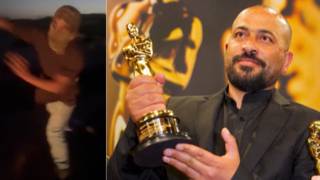
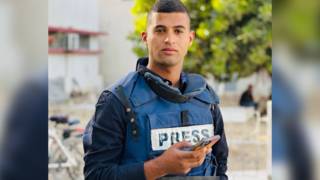
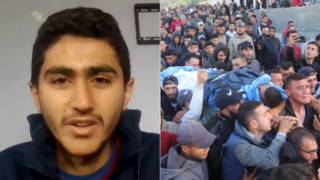
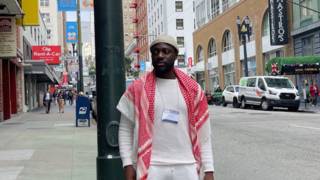



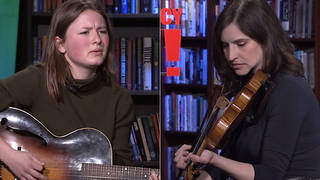

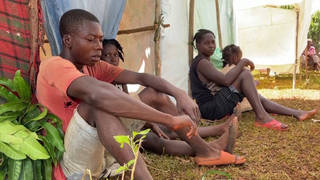
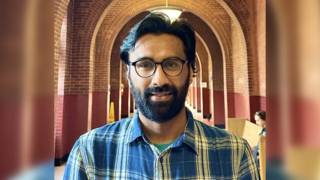
Media Options